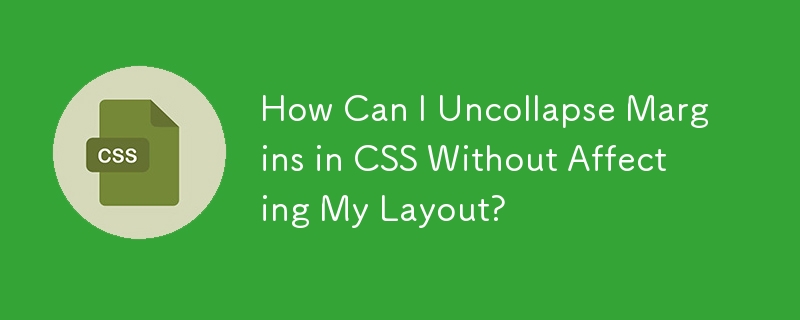How Can I Uncollapse Margins in CSS Without Affecting My Layout?

Uncollapsing Margins Without Altering Layout: A Comprehensive Guide
In CSS, collapsing margins can occur when adjacent elements share the same margin. This behavior is often an obstacle in achieving pixel-perfect layouts. While traditional solutions involve adding borders or padding, these methods may introduce unwanted visual effects. Here's a comprehensive guide to uncollapsing margins without compromising layout integrity:
Understanding Collapsing Margins
To grasp how to uncollapse margins, it's essential to understand the purpose of this feature. As per CSS specifications, vertical margins collapse when two or more elements have vertical margins applied directly to them or through their containing elements. This merging reduces the total vertical space between the elements.
Implementing a Hidden Overflow Div
A hidden overflow div is a practical solution to uncollapse margins without disrupting the layout. By inserting a transparent div with overflow set to hidden, height set to 0px, and width set to 0px between the elements, you can effectively break the collapsing behavior.
<html>
<body>
<div>This method preserves the intended margins and prevents them from collapsing. It's a subtle yet effective workaround for scenarios where visual modifications are undesirable.
Conclusion
The hidden overflow div technique offers a simple and non-intrusive approach to uncollapsing margins in CSS. It eliminates the need for borders or padding, allowing you to maintain pixel-perfect layouts without compromising visual integrity. Employ this method to achieve precise and visually appealing designs consistently.
The above is the detailed content of How Can I Uncollapse Margins in CSS Without Affecting My Layout?. For more information, please follow other related articles on the PHP Chinese website!

Hot AI Tools

Undresser.AI Undress
AI-powered app for creating realistic nude photos

AI Clothes Remover
Online AI tool for removing clothes from photos.

Undress AI Tool
Undress images for free

Clothoff.io
AI clothes remover

Video Face Swap
Swap faces in any video effortlessly with our completely free AI face swap tool!

Hot Article

Hot Tools

Notepad++7.3.1
Easy-to-use and free code editor

SublimeText3 Chinese version
Chinese version, very easy to use

Zend Studio 13.0.1
Powerful PHP integrated development environment

Dreamweaver CS6
Visual web development tools

SublimeText3 Mac version
God-level code editing software (SublimeText3)

Hot Topics
 Vue 3
Apr 02, 2025 pm 06:32 PM
Vue 3
Apr 02, 2025 pm 06:32 PM
It's out! Congrats to the Vue team for getting it done, I know it was a massive effort and a long time coming. All new docs, as well.
 A bit on ci/cd
Apr 02, 2025 pm 06:21 PM
A bit on ci/cd
Apr 02, 2025 pm 06:21 PM
I'd say "website" fits better than "mobile app" but I like this framing from Max Lynch:
 Can you get valid CSS property values from the browser?
Apr 02, 2025 pm 06:17 PM
Can you get valid CSS property values from the browser?
Apr 02, 2025 pm 06:17 PM
I had someone write in with this very legit question. Lea just blogged about how you can get valid CSS properties themselves from the browser. That's like this.
 Using Markdown and Localization in the WordPress Block Editor
Apr 02, 2025 am 04:27 AM
Using Markdown and Localization in the WordPress Block Editor
Apr 02, 2025 am 04:27 AM
If we need to show documentation to the user directly in the WordPress editor, what is the best way to do it?
 Stacked Cards with Sticky Positioning and a Dash of Sass
Apr 03, 2025 am 10:30 AM
Stacked Cards with Sticky Positioning and a Dash of Sass
Apr 03, 2025 am 10:30 AM
The other day, I spotted this particularly lovely bit from Corey Ginnivan’s website where a collection of cards stack on top of one another as you scroll.
 Comparing Browsers for Responsive Design
Apr 02, 2025 pm 06:25 PM
Comparing Browsers for Responsive Design
Apr 02, 2025 pm 06:25 PM
There are a number of these desktop apps where the goal is showing your site at different dimensions all at the same time. So you can, for example, be writing
 How to Use CSS Grid for Sticky Headers and Footers
Apr 02, 2025 pm 06:29 PM
How to Use CSS Grid for Sticky Headers and Footers
Apr 02, 2025 pm 06:29 PM
CSS Grid is a collection of properties designed to make layout easier than it’s ever been. Like anything, there's a bit of a learning curve, but Grid is
 Google Fonts Variable Fonts
Apr 09, 2025 am 10:42 AM
Google Fonts Variable Fonts
Apr 09, 2025 am 10:42 AM
I see Google Fonts rolled out a new design (Tweet). Compared to the last big redesign, this feels much more iterative. I can barely tell the difference






